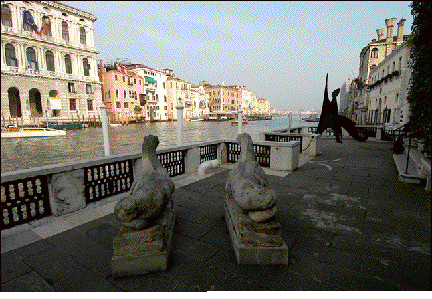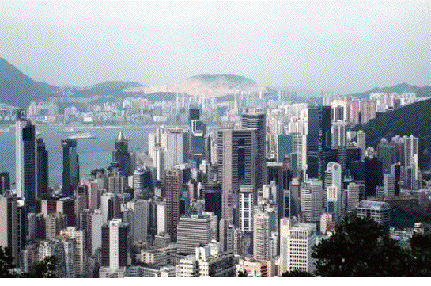The Eco-Metropolis
March 26, 2006
There is a group of people who have been calling themselves the “New Urbanists.” Basically, they think that post-World War II suburban development is a load of garbage, and they’re looking for alternatives. Jim Kunstler (www.kunstler.com) has been their most eloquent spokesperson. For the most part, I agree with their criticisms. I am also a big Jim Kunstler fan, by the way, and recommend that you buy and read his books.
One may wonder what this sort of thing has to do about “economics,” but the city is what the economy actually is, in its physical form. It might also be argued that “economic growth” that produces more of a horrid system that makes everyone miserable is not good economics.
The various criticisms of the suburban wasteland (they started appearing at the same time as the first Levittown boxes) have taken on a new urgency, as people are gradually realizing that not only is suburban car-dependent living a drag, and grossly wasteful, it is also becoming something like impossible, as car dependency/big house dependency translates into energy dependency, which is going to cause problems as fossil fuel production enters its long decline phase. (www.lifeaftertheoilcrash.net, www.peakoil.net, www.dieoff.org)
The “New Urbanists” have been looking around for an alternative to big car/big house/big box retail living, and have tended to focus on the “Small Town America” model, which is basically a 19th century agrarian format that extended up to the end of World War II. Nothing wrong with this. It seems to have made people happy enough, bringing fond feelings even today to those who never lived in it but see its skeleton and representation in Norman Rockwell paintings. (And who is the painter–or photographer–of Suburban America? There isn’t one, because there’s nothing there to paint.) On their weekends, people still get in their cars and drive long distances to spend some time in the nicer remains of Small Town America, such as Woodstock, VT or New Paltz, NY.
Wealthy suburbs around the country still aim for a “wooded country” feel, which they do indeed accomplish, mainly by imposing restrictions on houses per acre that make it impossible to live there unless you can afford a lot of land. Isn’t it obvious that this tends to create sprawl and long commutes? Suburban ideals themselves gravitate toward this “Small Town America” format, although the end result of everyone trying to live in “Small Town America” has been colossal, low density metropolises. It is not a format that works with lots of people. Which is why those with money always gravitate towards even lower density, so they can further emulate small town living (typically at grotesque expense), even though they live in a big city, and have big-city jobs, which allow them the money to live like farmers in the big city. In short, the Martha Stewart Fantasy.
The “New Urbanists” also have another problem, which is that they have to sell their wares (property developments) within the context of the vast suburb, so, while declaring their horror (quite rightly) at Parking Lot America, they nevertheless must design something that fits within the car-dependent lifestyle. Thus, the “New Urbanists” and the “Old Suburbanists” share two things: their “Small Tow America” ideal, and their attachment to car dependency. Thus, I like to call the “New Urbanists” the New Suburbanists. They have a plan for a nicer small town/suburb. And it’s a good plan. But it won’t work very well for a big city, which is where most people live.
The main problem with the New Suburbanists is that they don’t have any examples to work from. There is really only one true urban environment in the United States, which is of course New York. San Francisco is close. New York is not a very good example of a true urban ideal. Although it’s a lot nicer than it was, people still associate it with the disaster it became in the 1970s. For a long time it was a sort of immigrant industrial hell, of unsanitary tenements and general capitalistic exploitation. Today, it still has a terrible divide between rich and poor — the middle class deserts when they decide to have kids, and face the choice of either the horrid public schools or the hideously expensive private ones — and is often a dirty, mucky sort of place. Probably not a good place to retire either.
It’s easy to see why the New Suburbanists don’t adopt New York, the only urban place in North America, as their Urban (metropolitan) Ideal. No, it’s Small Town America, which has been the ideal of people leaving New York for over a hundred years.
Now, the funny thing is that the New Suburbanists don’t hold any other urban place as an ideal either. They don’t point to a single urban place in the world and say, “yes, this is what I want.” But the fact is, the world has a good selection of functioning, enjoyable, pleasant metropolises. Tokyo is my favorite, but it’s hard to say anything bad about Singapore (except that it’s not as much fun as Tokyo). Hong Kong is nice. The better bits of London and Paris used to inspire people — they inspired the people who built New York and downtown San Francisco — but apparently that well has run dry as far as the New Suburbanists are concerned. And the lovely cities of Italy, or for that matter the exquisite “hill towns”? Yes, I know that certain New Suburbanists can appreciate the hill towns of Italy (“small townä.small townä”), like every other tourist that flocks there from around the world, but they don’t seem at all inclined to learn from the example and try to actually design and build something similar. Viennaä.no? Bangkok has some traffic problems, but it has wonderful super-dense neighborhoods. I’m fond of the Don Muang district by the airport. The water taxis are way cool.

Viennaäthat’s soooo not Small Town America. Where would you park?
My definition of an urban environment is one where it is easier to not own a car than to own one. New York, London, Paris, Hong Kong, Tokyo, and Singapore fit this description. Oddly enough, it is not necessary to be in a big city to be in an urban environment. There are many small towns/cities around the world that also fit this description, like the aforementioned Italian hill towns, or maybe little towns on the sea in Greece. Note that I said it is easier not to own a car, meaning that one can go about the business of life (going to work, shopping etc.) without a car. It may well be more fun to have a car, if you can afford it, which is also the case for New York, but even in this case the car tends to be used only every other weekend.

Hong Kong. Tough to park, but that’s not a problem if you don’t own a car!
Can’t paste this Google satellite photo of Tokyo, but click here:
http://maps.google.com/maps?f=q&hl=en&q=tokyo&ll=35.623522,139.673443&spn=0.002006,0.005193&t=k
This is actually my old neighborhood, the Yagumo neighborhood of Meguro-Ku. This is a combination of small stores, apartment buildings, offices, and single-family detached houses. A rather ritzy residential neighborhood, actually, and a wonderful place! I didn’t own a car for five years, and it was heaven.
Here’s a satellite photo of Phoenix, Arizona. Believe it or not, the scale on the photos is the same.
Do you see the difference? Which one looks easier to walk around?
Amsterdam:
http://maps.google.com/maps?f=q&hl=en&q=tokyo&ll=35.623522,139.673443&spn=0.002006,0.005193&t=k
To round up this before it gets much longer (that will be for another day), let us conclude that it is high time we in this suburban cesspool known as the United States figure out how to build real cities, and stop fantasizing about Small Town America. I think I’ve found out how to build real cities, and the secret is so simple that even a New Suburbanist can understand it. Here it is:
Really narrow streets.
Go ahead, go to all the urban places you love the best, whether in Tokyo, in the Italian hill towns, in SoHo in New York or the Upper West side, Greenwich Village, downtown San Francisco, Waikiki (to some degree), Vancouver, Paris, the local indoor shopping mall or wherever, and the common denominator between them all is really narrow streets. Try it, you’ll see what I mean. I honestly believe that if you have really narrow streets, the rest will take care of itself. Narrow streets = things are close together = easy to walk = hard to park = hard to drive = no wasted space = a city full of “stuff” rather than “non-stuff” like parking lots, superwide roadways and throwaway greenery = architecture that is to be appreciated by a close-up pedestrian rather than from a helicopter or an interstate highway = lots of fun.
Yes, there are cities with wonderful “Grand Boulevards,” and realistically you are going to need a way for trucks to get around to supply the stores and whatnot, but what you want are a handful of “Grand Boulevards” combined with swathes of neighborhoods with really narrow streets, which is where the action is. Sort of an artery-capillary effect. Like central Paris. Look for yourself.
People often get confused about “consumption” and believe that living in cities is more consumptive of natural resources than living in the country. This is because it typically costs more money to live in a city than in the country. A big-city job lets you indulge in lots of “conspicuous consumption,” like spending $60 for a t-shirt instead of $5. The fact of the matter is, however, that living in an urban environment is less consumptive of resources, which is probably why people living in urban Europe and Japan consume half the energy per capita of those attempting to live in “Small Town America” in the United States! Yes, you can run your car on biodiesel (at a vast cost of environmental destruction as tropical forests are mown down to grow palm oil for biodiesel use), but it is better to take the train, which uses 1/10th the energy per passenger/mile as an automobile, plus you’d be traveling fewer miles, because you wouldn’t be coming in from your Small Town in the Suburbs.
If you want people to “get out of their cars,” you can’t abandon them in the middle of a car-dependent wasteland like the US suburbs. The way to get people to not drive is to entice them to a location where it is easier to not own a car than to own one — in other words, it is time to build real cities, and not supergigantic “Small Towns.” Unlike New York, the cities will have to be livable throughout one’s lifetime, which, in practical terms today, means good schools, whether public or publicly supported, through perhaps a voucher program. There has been some evidence that people are sick and tired of suburbia, and ready to migrate to somewhere more urban, because, quite simply, it’s more fun. Thus, all the condos going up on Miami Beach!

